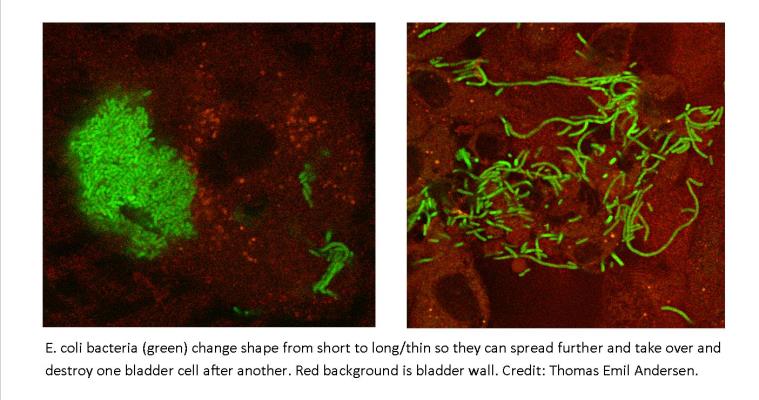
Towards better treatment of cystitis
Every year, millions of people are treated for cystitis, but despite its prevalence, the disease is still a scientific mystery. Now a research team has succeeded in identifying how the bacteria responsible for the disease cause the disease to develop. This is a cause for optimism that more effective treatment methods can be developed.
You feel the urge to urinate every two minutes, but you can only manage to squeeze out a few drops, and it stings terribly. Almost every woman has experienced cystitis, and some even experience it as a recurring annoyance.
In cases of a bacterial infection, the doctor may prescribe antibiotics. But these bacteria have a special ability to survive this treatment and cause a new infection.
Now a Danish research team is reporting that they have made a discovery that potentially could lead to a new and radically different method of treatment.
Systematic monitoring of the bladder wall
The research team has developed a model that enables systematic observation and analysis of bacteria from each step in the bacteria’s invasion of the bladder wall.
"Now we know important details on how the bacterium enters the phases that poses a threat. And we know how we can potentially prevent the bacteria from reaching that stage” explains head of research Jacob Møller-Jensen from the Department of Biochemistry and Molecular Biology at the University of Southern Denmark.
The research team also consists of Postdoc Surabhi Khandige, Department of Biochemistry and Molecular Biology, as well as participants from the Department of Clinical Microbiology at Odense University Hospital, led by senior researcher Thomas Emil Andersen, Department of Clinical Research.
The bacteria attach themselves to the inside of the bladder
Cystitis is usually due to special E. coli bacteria, which are able to invade cells in the urinary tract. The bacteria attach themselves to the inside of the bladder and grow. In response, the bladder rejects the outer layer of cells and thereby flushes many of the bacteria out in the urine. This produces the cloudy urine that is typical of a urinary tract infection.
However, some E. coli bacteria are cunning enough to avoid being flushed out. In a fascinating way, they alter their form and become extremely long (a process known as filamentation). This improves their ability to attach themselves to the bladder wall and thus avoid being flushed out. This in turn sets the stage for the bacteria to spread further and to take over and destroy one bladder cell after another. Finally, the bacteria reach the bottom layer of bladder cells, which they penetrate and then stop dividing. At this stage, neither antibiotics nor the body's immune system can reach the bacteria.

Become long and thin
"Scientists have long known that this bacterium is capable of some very specific tricks, including changing shape during the infection. But until now it has been difficult to discover how the bacterium manages this", explains Surabhi Khandige.
"The bacteria's ability to form long filaments is crucial to their ability to spread and thus for cystitis to develop".
In order to study the bacteria's behaviour, the researchers constructed an artificial bladder model. The principle of the model is that the inside of a small chamber is lined with bladder cells, and when they have established themselves, human urine is sent into the chamber, thereby producing an artificial bladder. Then the E. coli bacteria are sent in and their activity is monitored.
"We studied the course of the infection through a microscope and we collected and studied bacteria from the various stages of the infection process. This enabled us to identify the mechanism that causes the bacteria to become filamentous. This is the first time such a detailed insight has been achieved, and it provides obvious opportunities to control this bacterium’s activities and prevent the initial stage of the infection", says Jacob Møller-Jensen.
Mice did not develop cystitis
In the laboratory, the researchers tried to deactivate the mechanism that usually makes the bacteria long and thin. The ability of the bacteria to cause cystitis was then tested in mouse studies.
"Not only did we see that the bacteria were unable to cause a robust infection. We also saw that the bacterium's ability to penetrate into the deeper layers of the bladder wall declined sharply. In other words, when we deactivate the mechanism, we undermine the bacterium” says Thomas Emil Andersen, and continues:
"This offers hope that we can devise new treatment strategies to prevent problematic and recurrent urinary tract infections".
Salmonella behaves in the same way
E. coli is not the only bacterium that uses filamentation as a survival strategy. The same phenomenon can be observed, for example, in Salmonella and Klebsiella, which today are resistant to many antibiotics.
"It will be interesting to examine whether these bacteria can be controlled in the same way", says Thomas Emil Andersen.
The researchers have published their findings in the journal mBio and at the conference Clinical and Scientific Advances in Urinary Tract Infections Conference, 26-28 August, 2016, in Columbus, Ohio.